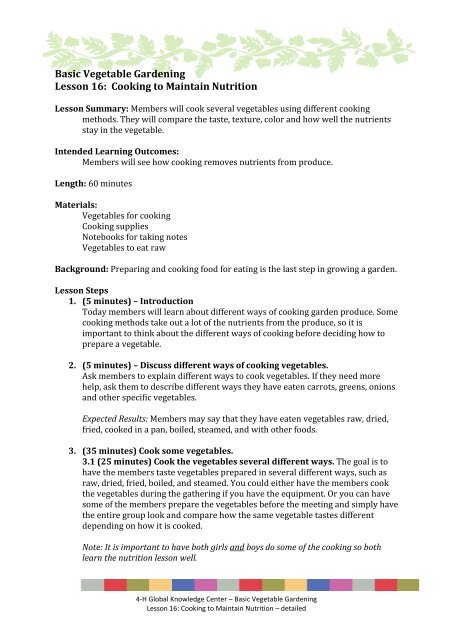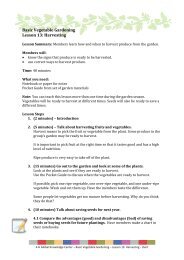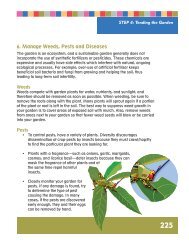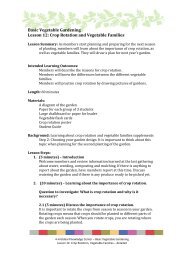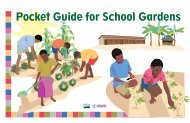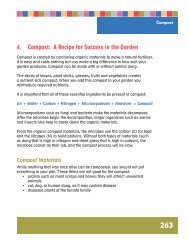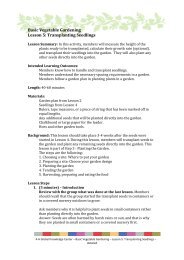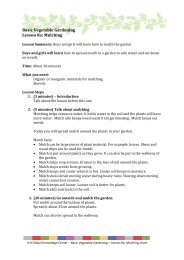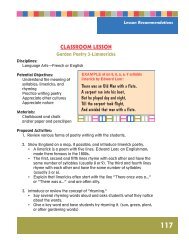Cooking to Maintain Nutrition - 4-H Africa Knowledge Center.
Cooking to Maintain Nutrition - 4-H Africa Knowledge Center.
Cooking to Maintain Nutrition - 4-H Africa Knowledge Center.
You also want an ePaper? Increase the reach of your titles
YUMPU automatically turns print PDFs into web optimized ePapers that Google loves.
Basic Vegetable Gardening<br />
Lesson 16: <strong>Cooking</strong> <strong>to</strong> <strong>Maintain</strong> <strong>Nutrition</strong><br />
Lesson Summary: Members will cook several vegetables using different cooking<br />
methods. They will compare the taste, texture, color and how well the nutrients<br />
stay in the vegetable.<br />
Intended Learning Outcomes:<br />
Members will see how cooking removes nutrients from produce.<br />
Length: 60 minutes<br />
Materials:<br />
Vegetables for cooking<br />
<strong>Cooking</strong> supplies<br />
Notebooks for taking notes<br />
Vegetables <strong>to</strong> eat raw<br />
Background: Preparing and cooking food for eating is the last step in growing a garden.<br />
Lesson Steps<br />
1. (5 minutes) – Introduction<br />
Today members will learn about different ways of cooking garden produce. Some<br />
cooking methods take out a lot of the nutrients from the produce, so it is<br />
important <strong>to</strong> think about the different ways of cooking before deciding how <strong>to</strong><br />
prepare a vegetable.<br />
2. (5 minutes) – Discuss different ways of cooking vegetables.<br />
Ask members <strong>to</strong> explain different ways <strong>to</strong> cook vegetables. If they need more<br />
help, ask them <strong>to</strong> describe different ways they have eaten carrots, greens, onions<br />
and other specific vegetables.<br />
Expected Results: Members may say that they have eaten vegetables raw, dried,<br />
fried, cooked in a pan, boiled, steamed, and with other foods.<br />
3. (35 minutes) Cook some vegetables.<br />
3.1 (25 minutes) Cook the vegetables several different ways. The goal is <strong>to</strong><br />
have the members taste vegetables prepared in several different ways, such as<br />
raw, dried, fried, boiled, and steamed. You could either have the members cook<br />
the vegetables during the gathering if you have the equipment. Or you can have<br />
some of the members prepare the vegetables before the meeting and simply have<br />
the entire group look and compare how the same vegetable tastes different<br />
depending on how it is cooked.<br />
Note: It is important <strong>to</strong> have both girls and boys do some of the cooking so both<br />
learn the nutrition lesson well.<br />
4-H Global <strong>Knowledge</strong> <strong>Center</strong> – Basic Vegetable Gardening<br />
Lesson 16: <strong>Cooking</strong> <strong>to</strong> <strong>Maintain</strong> <strong>Nutrition</strong> – detailed
3.2 Compare (10 minutes) Write this chart on the board and fill it out with<br />
descriptions of the taste and texture of each vegetable. Change the chart as<br />
needed.<br />
Vegetable Dried Raw Boiled Steamed<br />
Carrots<br />
Sweet Pota<strong>to</strong><br />
Greens<br />
3.2 Discuss the taste of each of the foods cooked different ways.<br />
Which cooking methods did they like best for each vegetable?<br />
Which cooking method is the most practical for our households?<br />
Did any of our foods change color? (This is most likely <strong>to</strong> happen with green<br />
foods or cauliflower.) Sometimes the color changes due <strong>to</strong> the acid in the foods.<br />
This does not change the nutrition of the food.<br />
4. (10 minutes) Discuss the nutritional value of the vegetables.<br />
Ask the students which type of preparation they thought was the healthiest. Ask<br />
several members for their opinions and ask them <strong>to</strong> explain their opinions.<br />
Tell students that most foods are healthier when they are eaten as directly from<br />
the garden as possible (and washed). Vitamins are very sensitive <strong>to</strong> heat, water<br />
and oxygen and are easily destroyed when we bake, cook or dry the fruit and<br />
vegetables that contain them.<br />
For example, when we boil greens, many of the vitamins move from the greens<br />
in<strong>to</strong> the water. When we cook <strong>to</strong>ma<strong>to</strong>es, some of the vitamin C is destroyed by<br />
the heat. Drying yellow- or orange-fleshed sweet pota<strong>to</strong>es destroys the vitamin A<br />
that helps our eyes.<br />
Explain that it is best <strong>to</strong> cook fruits and vegetables with as little water – and in as<br />
short a time – as possible. That way, when you pour off the excess water, you are<br />
pouring out fewer nutrients. Better yet, do not waste the water and instead use it<br />
as a base for soup or sauce.<br />
5. (2 minutes) Ask the members <strong>to</strong> summarize what they learned.<br />
• Do not overcook – cook as lightly as possible.<br />
• Try steaming rather than boiling.<br />
• Cook using very little water. This works best with vegetables that are not<br />
4-H Global <strong>Knowledge</strong> <strong>Center</strong> – Basic Vegetable Gardening<br />
Lesson 16: <strong>Cooking</strong> <strong>to</strong> <strong>Maintain</strong> <strong>Nutrition</strong> – detailed
over-ripe.<br />
• If you boil vegetables, use the water for soup or sauce.<br />
• Make dishes like soups and stews that use the cooking water as part of the<br />
dish.<br />
• Put fruit and vegetable peels on the compost heap. This will improve the<br />
nutrition of the soil.<br />
6. (5 minutes) - Summary and Debrief<br />
Ask the members these questions:<br />
How does the cooking method affect the taste, texture, smell, and color of<br />
the vegetable?<br />
Answer: Sometimes the color changes due <strong>to</strong> the acid in the foods. Some<br />
methods, such as boiling, make the food softer. Steaming keeps it crispy.<br />
How does the cooking affect the nutrient content of the vegetable?<br />
Answer: The longer food is cooked, the more nutrients are destroyed by<br />
heat or leached in<strong>to</strong> the cooking water.<br />
What does orange- or green-colored cooking water indicate?<br />
Answer: The color shows how nutrients are lost in boiling.<br />
What did you discover about eating vegetables prepared differently?<br />
Answers will vary.<br />
What is the best way <strong>to</strong> prepare each of the foods <strong>to</strong> have them be the<br />
most nutritious while still tasty and appealing?<br />
Answer: Will vary by food. Boiling is a poor method because many<br />
nutrients are thrown away with the water. Steaming is better than boiling.<br />
However, boiling is very common in <strong>Africa</strong>. Discuss the best way <strong>to</strong> boil <strong>to</strong><br />
preserve vitamins.<br />
How can people who are food insecure make the most of the food they do<br />
have?<br />
Answer: Responses will vary<br />
7. (1 minute) - Close<br />
<strong>Cooking</strong> and eating are the last steps in food production. Review with the boys<br />
and girls some of the things they’ve learned since they first planned and planted<br />
a garden. Discuss what lesson will be next.<br />
4-H Global <strong>Knowledge</strong> <strong>Center</strong> – Basic Vegetable Gardening<br />
Lesson 16: <strong>Cooking</strong> <strong>to</strong> <strong>Maintain</strong> <strong>Nutrition</strong> – detailed


